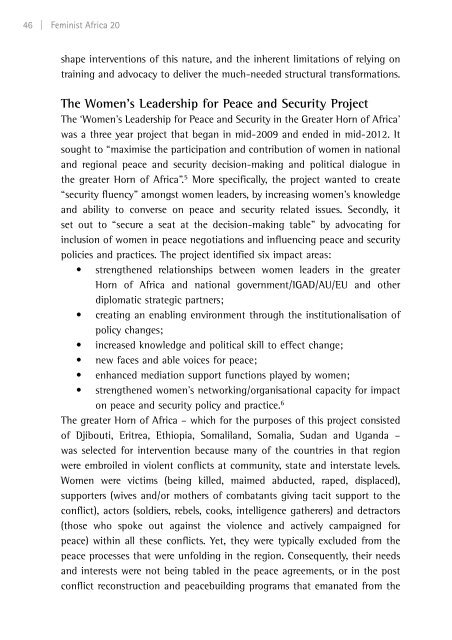Create successful ePaper yourself
Turn your PDF publications into a flip-book with our unique Google optimized e-Paper software.
46 | Feminist Africa 20<br />
shape interventions of this nature, <strong>and</strong> the inherent limitations of relying on<br />
training <strong>and</strong> advocacy to deliver the much-needed structural transformations.<br />
The Women’s Leadership for Peace <strong>and</strong> Security Project<br />
The ‘Women’s Leadership for Peace <strong>and</strong> Security in the Greater Horn of Africa’<br />
was a three year project that began in mid-2009 <strong>and</strong> ended in mid-2012. It<br />
sought to “maximise the participation <strong>and</strong> contribution of women in national<br />
<strong>and</strong> regional peace <strong>and</strong> security decision-making <strong>and</strong> political dialogue in<br />
the greater Horn of Africa”. 5 More specifically, the project wanted to create<br />
“security fluency” amongst women leaders, by increasing women’s knowledge<br />
<strong>and</strong> ability to converse on peace <strong>and</strong> security related issues. Secondly, it<br />
set out to “secure a seat at the decision-making table” by advocating for<br />
inclusion of women in peace negotiations <strong>and</strong> influencing peace <strong>and</strong> security<br />
policies <strong>and</strong> practices. The project identified six impact areas:<br />
• strengthened relationships between women leaders in the greater<br />
Horn of Africa <strong>and</strong> national government/IGAD/AU/EU <strong>and</strong> other<br />
diplomatic strategic partners;<br />
• creating an enabling environment through the institutionalisation of<br />
policy changes;<br />
• increased knowledge <strong>and</strong> political skill to effect change;<br />
• new faces <strong>and</strong> able voices for peace;<br />
• enhanced mediation support functions played by women;<br />
• strengthened women’s networking/organisational capacity for impact<br />
on peace <strong>and</strong> security policy <strong>and</strong> practice. 6<br />
The greater Horn of Africa – which for the purposes of this project consisted<br />
of Djibouti, Eritrea, Ethiopia, Somalil<strong>and</strong>, Somalia, Sudan <strong>and</strong> Ug<strong>and</strong>a –<br />
was selected for intervention because many of the countries in that region<br />
were embroiled in violent conflicts at community, state <strong>and</strong> interstate levels.<br />
Women were victims (being killed, maimed abducted, raped, displaced),<br />
supporters (wives <strong>and</strong>/or mothers of combatants giving tacit support to the<br />
conflict), actors (soldiers, rebels, cooks, intelligence gatherers) <strong>and</strong> detractors<br />
(those who spoke out against the violence <strong>and</strong> actively campaigned for<br />
peace) within all these conflicts. Yet, they were typically excluded from the<br />
peace processes that were unfolding in the region. Consequently, their needs<br />
<strong>and</strong> interests were not being tabled in the peace agreements, or in the post<br />
conflict reconstruction <strong>and</strong> peacebuilding programs that emanated from the


